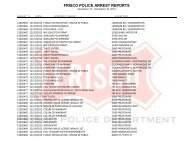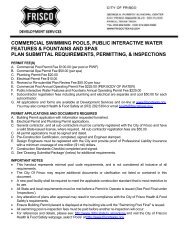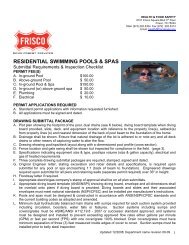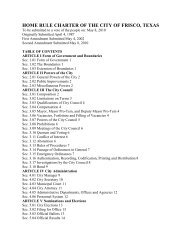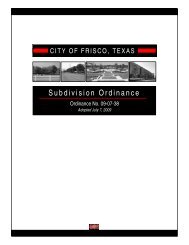- Page 1 and 2:
Version 6/19/12 Engineering Standar
- Page 3 and 4:
Engineering Standards Version 6/19/
- Page 5 and 6:
Engineering Standards Version 6/19/
- Page 7 and 8:
Engineering Standards Version 6/19/
- Page 9 and 10:
Engineering Standards Version 6/19/
- Page 11 and 12:
Engineering Standards Version 6/19/
- Page 13 and 14:
Engineering Standards Version 6/19/
- Page 15 and 16:
Engineering Standards Version 6/19/
- Page 17 and 18:
Engineering Standards Version 6/19/
- Page 19 and 20:
Engineering Standards Version 6/19/
- Page 21 and 22:
Engineering Standards Version 6/19/
- Page 23 and 24:
Engineering Standards Version 6/19/
- Page 25 and 26:
Engineering Standards Version 6/19/
- Page 27 and 28:
Engineering Standards Version 6/19/
- Page 29 and 30:
Engineering Standards Version 6/19/
- Page 31 and 32:
Engineering Standards Version 6/19/
- Page 33 and 34:
Engineering Standards Version 6/19/
- Page 35 and 36:
Engineering Standards Version 6/19/
- Page 37 and 38:
Engineering Standards Version 6/19/
- Page 39 and 40:
Engineering Standards Version 6/19/
- Page 41 and 42:
Engineering Standards Version 6/19/
- Page 43 and 44:
Engineering Standards Version 6/19/
- Page 45 and 46:
Engineering Standards Version 6/19/
- Page 47 and 48:
Engineering Standards Version 6/19/
- Page 49 and 50:
Engineering Standards Version 6/19/
- Page 51 and 52:
Engineering Standards Version 6/19/
- Page 53 and 54:
Engineering Standards Version 6/19/
- Page 55 and 56:
Engineering Standards Version 6/19/
- Page 57 and 58:
Engineering Standards Version 6/19/
- Page 59 and 60:
Engineering Standards Version 6/19/
- Page 61 and 62:
Engineering Standards Version 6/19/
- Page 63 and 64:
Engineering Standards Version 6/19/
- Page 65 and 66:
Engineering Standards Version 6/19/
- Page 67 and 68:
Engineering Standards Version 6/19/
- Page 69 and 70: Engineering Standards Version 6/19/
- Page 71 and 72: Engineering Standards Version 6/19/
- Page 73 and 74: Engineering Standards Version 6/19/
- Page 75 and 76: Engineering Standards Version 6/19/
- Page 77 and 78: Engineering Standards Version 6/19/
- Page 79 and 80: Engineering Standards Version 6/19/
- Page 81 and 82: Engineering Standards Version 6/19/
- Page 83 and 84: Engineering Standards Version 6/19/
- Page 85 and 86: Engineering Standards Version 6/19/
- Page 87 and 88: Engineering Standards Version 6/19/
- Page 89 and 90: Engineering Standards Version 6/19/
- Page 91 and 92: Engineering Standards Version 6/19/
- Page 93 and 94: Engineering Standards Version 6/19/
- Page 95 and 96: Engineering Standards Version 6/19/
- Page 97 and 98: Engineering Standards Version 6/19/
- Page 99 and 100: Engineering Standards Version 6/19/
- Page 101 and 102: Engineering Standards Version 6/19/
- Page 103 and 104: Engineering Standards Version 6/19/
- Page 105 and 106: Engineering Standards Version 6/19/
- Page 107 and 108: Engineering Standards Version 6/19/
- Page 109 and 110: Engineering Standards Version 6/19/
- Page 111 and 112: Engineering Standards Version 6/19/
- Page 113 and 114: Engineering Standards Version 6/19/
- Page 115 and 116: Engineering Standards Version 6/19/
- Page 117 and 118: Engineering Standards Version 6/19/
- Page 119: Engineering Standards Version 6/19/
- Page 123 and 124: Engineering Standards Version 6/19/
- Page 125 and 126: Engineering Standards Version 6/19/
- Page 127 and 128: Engineering Standards Version 6/19/
- Page 129 and 130: Engineering Standards Version 6/19/
- Page 131 and 132: Engineering Standards Version 6/19/
- Page 133 and 134: Engineering Standards Version 6/19/
- Page 135 and 136: Engineering Standards Version 6/19/
- Page 137 and 138: Engineering Standards Version 6/19/
- Page 139 and 140: Engineering Standards Version 6/19/
- Page 141 and 142: Engineering Standards Version 6/19/
- Page 143 and 144: Engineering Standards Version 6/19/
- Page 145 and 146: Engineering Standards Version 6/19/
- Page 147 and 148: Engineering Standards Version 6/19/
- Page 149 and 150: Engineering Standards Version 6/19/
- Page 151 and 152: Engineering Standards Version 6/19/
- Page 153 and 154: Engineering Standards Version 6/19/
- Page 155 and 156: Engineering Standards Version 6/19/
- Page 157 and 158: Engineering Standards Version 6/19/
- Page 159 and 160: Engineering Standards Version 6/19/
- Page 161 and 162: Engineering Standards Version 6/19/
- Page 163 and 164: Engineering Standards Version 6/19/
- Page 165 and 166: Engineering Standards Version 6/19/
- Page 167 and 168: Engineering Standards Version 6/19/
- Page 169 and 170: Engineering Standards Version 6/19/
- Page 171 and 172:
Engineering Standards Version 6/19/
- Page 173 and 174:
Engineering Standards Version 6/19/
- Page 175 and 176:
Engineering Standards Version 6/19/
- Page 177 and 178:
Engineering Standards Version 6/19/
- Page 179 and 180:
Engineering Standards Version 6/19/
- Page 181 and 182:
Engineering Standards Version 6/19/
- Page 183 and 184:
Engineering Standards Version 6/19/
- Page 185 and 186:
Engineering Standards Version 6/19/
- Page 187 and 188:
Version 6/19/12 TS TECHNICAL SPECIF
- Page 189 and 190:
Version 6/19/12 321123 Sand Bedding
- Page 191 and 192:
Version 6/19/12 SECTION 015813 PROJ
- Page 193 and 194:
Version 6/19/12 SECTION 017416 DUST
- Page 195 and 196:
Version 6/19/12 PART 2 - PRODUCTS N
- Page 197 and 198:
Version 6/19/12 SECTION 032200 WELD
- Page 199 and 200:
Version 6/19/12 SECTION 033101 DRIL
- Page 201 and 202:
Version 6/19/12 PART 1 - GENERAL 1.
- Page 203 and 204:
Version 6/19/12 SECTION 034100 CONC
- Page 205 and 206:
Version 6/19/12 SECTION 071300 MOIS
- Page 207 and 208:
Version 6/19/12 approved by the cit
- Page 209 and 210:
Version 6/19/12 E. The service encl
- Page 211 and 212:
Version 6/19/12 C. The assembly wil
- Page 213 and 214:
Version 6/19/12 SECTION 265620 LUMI
- Page 215 and 216:
Version 6/19/12 SECTION 270500 COND
- Page 217 and 218:
Version 6/19/12 PART 4 - MEASUREMEN
- Page 219 and 220:
Version 6/19/12 4.02 PAYMENT the re
- Page 221 and 222:
Version 6/19/12 SECTION 312323 SELE
- Page 223 and 224:
Version 6/19/12 4.02 PAYMENT by the
- Page 225 and 226:
Version 6/19/12 PART 3 - EXECUTION
- Page 227 and 228:
Version 6/19/12 SECTION 313600 GABI
- Page 229 and 230:
Version 6/19/12 SECTION 321112 MOIS
- Page 231 and 232:
Version 6/19/12 SECTION 321113 LIME
- Page 233 and 234:
Version 6/19/12 PART 3 - EXECUTION
- Page 235 and 236:
Version 6/19/12 Minimum passing 3/4
- Page 237 and 238:
Version 6/19/12 inch and not more t
- Page 239 and 240:
Version 6/19/12 PART 1 - GENERAL 1.
- Page 241 and 242:
Version 6/19/12 SECTION 321126 ASPH
- Page 243 and 244:
Version 6/19/12 SECTION 321216 HOT
- Page 245 and 246:
Version 6/19/12 PART 3 - EXECUTION
- Page 247 and 248:
Version 6/19/12 PART 3 - EXECUTION
- Page 249 and 250:
Version 6/19/12 SECTION 321400 CONC
- Page 251 and 252:
Version 6/19/12 SECTION 321645 DRIV
- Page 253 and 254:
Version 6/19/12 4.02 PAYMENT A. All
- Page 255 and 256:
Version 6/19/12 4.02 PAYMENT A. All
- Page 257 and 258:
Version 6/19/12 4.02 PAYMENT A. All
- Page 259 and 260:
Version 6/19/12 SECTION 321723 PAVE
- Page 261 and 262:
Version 6/19/12 PART 4 - MEASUREMEN
- Page 263 and 264:
Version 6/19/12 PART 3 - EXECUTION
- Page 265 and 266:
Version 6/19/12 3.03 WARRANTY REQUI
- Page 267 and 268:
Version 6/19/12 SECTION 328000 IRRI
- Page 269 and 270:
Version 6/19/12 GUARANTEE FOR LANDS
- Page 271 and 272:
Version 6/19/12 2.03 PIPE FITTINGS:
- Page 273 and 274:
Version 6/19/12 B. Quick Coupling V
- Page 275 and 276:
Version 6/19/12 B. Mainline and Lat
- Page 277 and 278:
Version 6/19/12 PART 4 -MEASUREMENT
- Page 279 and 280:
Version 6/19/12 SECTION 329119 TOPS
- Page 281 and 282:
Version 6/19/12 2.02 FERTILIZER inc
- Page 283 and 284:
Version 6/19/12 3.04 PLANTING: rece
- Page 285 and 286:
Version 6/19/12 SECTION 329300 TREE
- Page 287 and 288:
Version 6/19/12 3. Alternate to B&B
- Page 289 and 290:
Version 6/19/12 3.09 CLEANUP All ex
- Page 291 and 292:
Version 6/19/12 SECTION 329600 REMO
- Page 293 and 294:
Version 6/19/12 SECTION 330131 WAST
- Page 295 and 296:
Version 6/19/12 PART 1 - GENERAL 1.
- Page 297 and 298:
Version 6/19/12 B. Refer to Public
- Page 299 and 300:
Version 6/19/12 A. Shop drawings of
- Page 301 and 302:
Version 6/19/12 Ventilation system
- Page 303 and 304:
Version 6/19/12 B. Section 331240 -
- Page 305 and 306:
Version 6/19/12 5. Apply a thin fil
- Page 307 and 308:
Version 6/19/12 SECTION 331114 PVC
- Page 309 and 310:
Version 6/19/12 PART 4 - MEASUREMEN
- Page 311 and 312:
Version 6/19/12 B. A tapping saddle
- Page 313 and 314:
Version 6/19/12 SECTION 331217 RESI
- Page 315 and 316:
Version 6/19/12 SECTION 331218 BUTT
- Page 317 and 318:
Version 6/19/12 SECTION 331219 FIRE
- Page 319 and 320:
Version 6/19/12 SECTION 331240 POLY
- Page 321 and 322:
Version 6/19/12 PART 1 - GENERAL 1.
- Page 323 and 324:
Version 6/19/12 PART 1 - GENERAL 1.
- Page 325 and 326:
Version 6/19/12 E. All residential
- Page 327 and 328:
Version 6/19/12 PART 3 - EXECUTION
- Page 329 and 330:
Version 6/19/12 C. Appurtenances sh
- Page 331 and 332:
Version 6/19/12 E. No connecting wa
- Page 333 and 334:
Version 6/19/12 PART 4 - MEASUREMEN
- Page 335 and 336:
Version 6/19/12 PART 4 - MEASUREMEN
- Page 337 and 338:
Version 6/19/12 D. Manholes deeper
- Page 339 and 340:
Version 6/19/12 SECTION 334113 REIN
- Page 341 and 342:
Version 6/19/12 SECTION 334200 REIN
- Page 343 and 344:
Version 6/19/12 SECTION 334914 HEAD
- Page 345 and 346:
Version 6/19/12 PART 1 - GENERAL 1.
- Page 347 and 348:
Version 6/19/12 C. All traffic sign
- Page 349 and 350:
Version 6/19/12 PART 4 - MEASUREMEN
- Page 351 and 352:
Version 6/19/12 PART 4 - MEASUREMEN
- Page 353 and 354:
Version 6/19/12 SECTION 344135 GROU
- Page 355 and 356:
Version 6/19/12 SECTION 344140 TEMP
- Page 357 and 358:
Version 6/19/12 PART 4 - MEASUREMEN
- Page 359 and 360:
Version 6/19/12 F. If, at any time
- Page 361 and 362:
Version 6/19/12 AM APPROVED MATERIA
- Page 363 and 364:
City of Frisco Approved Materials L
- Page 365 and 366:
City of Frisco Approved Materials L
- Page 367 and 368:
City of Frisco Approved Materials L
- Page 369 and 370:
City of Frisco Approved Materials L
- Page 371 and 372:
City of Frisco Approved Materials L
- Page 373 and 374:
Version 6/19/12 City of Frisco Appr
- Page 375 and 376:
City of Frisco Approved Materials L
- Page 377 and 378:
Version 6/19/12 SD STANDARD CONSTRU
- Page 379 and 380:
Version 6/19/12 D05 Recessed Curb I
- Page 381 and 382:
Version 6/19/12 City Logo (See Note
- Page 383 and 384:
STANDARD CONSTRUCTION DETAIL THOROU
- Page 385 and 386:
Version 6/19/12 STANDARD CONSTRUCTI
- Page 387 and 388:
Version 6/19/12 OPTION 1 OPTION 2 S
- Page 389 and 390:
Version 6/19/12 STREET HEADER AT EX
- Page 391 and 392:
Version 6/19/12 PLAN SECTION A-A SE
- Page 393 and 394:
Version 6/19/12 PLAN SECTION A-A ST
- Page 395 and 396:
Version 6/19/12 PLAN SECTION A-A ST
- Page 397 and 398:
Version 6/19/12 PLAN SECTION A-A SE
- Page 399 and 400:
Version 6/19/12 OPPOSING TRAFFIC GO
- Page 401 and 402:
Version 6/19/12 TYPICAL INSTALLATIO
- Page 403 and 404:
Version 6/19/12 STANDARD CONSTRUCTI
- Page 405 and 406:
Version 6/19/12 PLAN PROFILE STANDA
- Page 407 and 408:
Version 6/19/12 PLAN PROFILE STANDA
- Page 409 and 410:
Version 6/19/12 INLET SECTION FOR R
- Page 411 and 412:
Version 6/19/12 CLASS "B" STANDARD
- Page 413 and 414:
Version 6/19/12 CLASS "B-1" STANDAR
- Page 415 and 416:
Version 6/19/12 CLASS "G" STANDARD
- Page 417 and 418:
STANDARD CONSTRUCTION DETAIL INFILT
- Page 419 and 420:
Version 6/19/12 PLAN SECTION X-X
- Page 421 and 422:
Version 6/19/12 STANDARD CONSTR
- Page 423 and 424:
STANDARD CONSTRUCTION DETAIL THRUST
- Page 425 and 426:
Version 6/19/12 STANDARD CONSTRUCTI
- Page 427 and 428:
Version 6/19/12 ” ” ” STANDAR
- Page 429 and 430:
Version 6/19/12 STANDARD CONSTRUCTI
- Page 431 and 432:
Version 6/19/12 STANDARD CONSTRUCTI
- Page 433 and 434:
Version 6/19/12 PLAN VIEW SECTION S
- Page 435 and 436:
Version 6/19/12 PLAN VIEW SECTION S
- Page 437 and 438:
Version 6/19/12 ELEVATION FIELD INS
- Page 439 and 440:
Version 6/19/12 STANDARD CONSTRUCTI
- Page 441 and 442:
Version 6/19/12 STANDARD CONSTRUCTI
- Page 443 and 444:
Version 6/19/12 STANDARD CONSTRUCTI
- Page 445 and 446:
Version 6/19/12 PLAN VIEW INSTALLAT
- Page 447 and 448:
Version 6/19/12 PROFILE VIEW SECTIO
- Page 449 and 450:
Version 6/19/12 ELEVATION FIELD INS
- Page 451 and 452:
Version 6/19/12 PLAN SECTION STANDA
- Page 453 and 454:
Version 6/19/12 PLAN SECTION STANDA
- Page 455 and 456:
Version 6/19/12 STANDARD CONSTRUCTI
- Page 457 and 458:
Engineering Standards Version 6/19/
- Page 459 and 460:
Engineering Standards Version 6/19/
- Page 461 and 462:
Engineering Standards Version 6/19/




